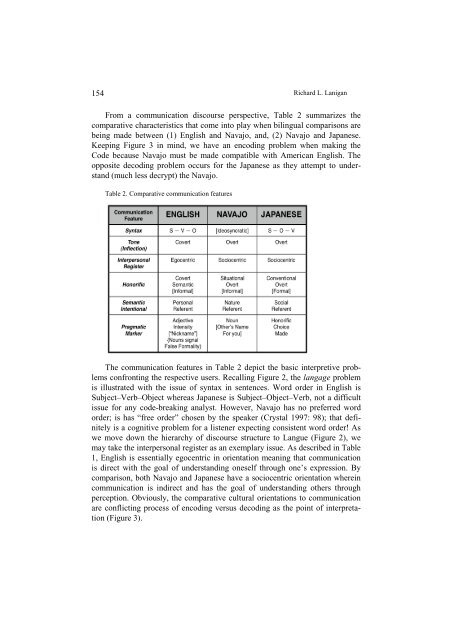s - Wyższa SzkoÅa Filologiczna we WrocÅawiu
s - Wyższa SzkoÅa Filologiczna we WrocÅawiu
s - Wyższa SzkoÅa Filologiczna we WrocÅawiu
Create successful ePaper yourself
Turn your PDF publications into a flip-book with our unique Google optimized e-Paper software.
154<br />
Richard L. Lanigan<br />
From a communication discourse perspective, Table 2 summarizes the<br />
comparative characteristics that come into play when bilingual comparisons are<br />
being made bet<strong>we</strong>en (1) English and Navajo, and, (2) Navajo and Japanese.<br />
Keeping Figure 3 in mind, <strong>we</strong> have an encoding problem when making the<br />
Code because Navajo must be made compatible with American English. The<br />
opposite decoding problem occurs for the Japanese as they attempt to understand<br />
(much less decrypt) the Navajo.<br />
Table 2. Comparative communication features<br />
The communication features in Table 2 depict the basic interpretive problems<br />
confronting the respective users. Recalling Figure 2, the langage problem<br />
is illustrated with the issue of syntax in sentences. Word order in English is<br />
Subject–Verb–Object whereas Japanese is Subject–Object–Verb, not a difficult<br />
issue for any code-breaking analyst. Ho<strong>we</strong>ver, Navajo has no preferred word<br />
order; is has “free order” chosen by the speaker (Crystal 1997: 98); that definitely<br />
is a cognitive problem for a listener expecting consistent word order! As<br />
<strong>we</strong> move down the hierarchy of discourse structure to Langue (Figure 2), <strong>we</strong><br />
may take the interpersonal register as an exemplary issue. As described in Table<br />
1, English is essentially egocentric in orientation meaning that communication<br />
is direct with the goal of understanding oneself through one’s expression. By<br />
comparison, both Navajo and Japanese have a sociocentric orientation wherein<br />
communication is indirect and has the goal of understanding others through<br />
perception. Obviously, the comparative cultural orientations to communication<br />
are conflicting process of encoding versus decoding as the point of interpretation<br />
(Figure 3).
















